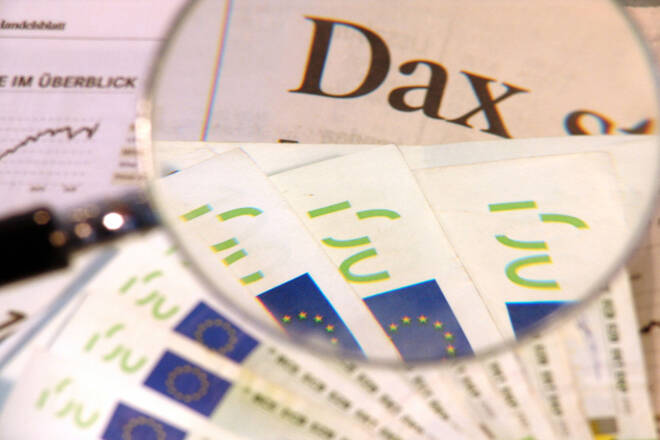Advertisement
Advertisement
DAX Index: German Inflation and US Employment Affecting DAX Market Trends
By:
DAX stocks buoyant as Beijing stimulus hopes offset concerns over German inflation and US economic indicators
Highlights
- The DAX extended its winning streak to three sessions, gaining 0.88% on Monday and ending the day at 15,931.
- This morning, stimulus hopes from Beijing provided comfort ahead of the US session despite German inflation concerns.
- Futures markets point to a bullish day ahead, with the DAX 30 up 48 points.
Tuesday Session Overview
On Tuesday, the DAX extended the winning streak to three sessions, gaining 0.88%. Following a 1.03% rally on Monday, the DAX ended the day at 15,931.
Reports of the PBoC planning to cut the Reserve Ratio Requirement supported a bullish Asian session. The DAX tracked the US and Asian markets into positive territory. The PBoC rumors followed Beijing’s efforts to ease pressure on the Chinese equity markets by reducing the stamp duty on stock trading.
However, German consumer sentiment figures tested buyer appetite before a US session breakout. The German GfK Consumer Climate Index fell from -24.6 to -25.5. Economists forecast a more modest fall to -24.3.
US consumer confidence also waned, with the CB Consumer Confidence Index falling from 114.0 to 106.1 in August. A slide in consumer confidence and a marked fall in JOLTs job openings eased bets on further Fed rate hikes, supporting riskier assets. JOLTs job openings fell from 9.165 million to 8.827 million in July.
The US equity markets responded to the shift in sentiment toward Fed monetary policy. On Tuesday, the NASDAQ rallied 1.74% on Monday, with the Dow and S&P 500 ending the day up 0.85% and 1.45%, respectively.
The Tuesday Market Movers
Listed companies exposed to China and tech stocks continued to make gains, while banks were also on the front foot.
Siemens Energy (+2.71%), Siemens AG (+1.51%), Infineon (+1.90%), and Adidas (+2.09%) were among the leading stocks.
Today, economic indicators from the euro area and the US will need consideration. Significantly, an unexpected pickup in German inflationary pressures would weigh on the DAX, with the ECB maintaining a hawkish policy stance.
However, stimulus hopes from Beijing will provide comfort ahead of the US session.
German Inflation and US ADP Nonfarm Employment in Focus
This morning, the Asian equity markets were on the charge for the third consecutive session. Market reaction to the Tuesday US economic indicators and influence on Fed interest rate expectations supported a breakout session.
Hopes of more stimulus from Beijing contributed to the positive first half of the week.
However, German inflation figures must reflect ECB efforts to curb inflation. Hotter-than-expected inflation would support a September ECB rate hike amidst a gloomy macroeconomic environment. Economists forecast the annual inflation rate to soften from 6.2% to 6.0%.
While the German inflation numbers will draw interest, we expect the US economic indicators to have more impact. ADP nonfarm employment change and second estimate GDP numbers for Q2 will be in focus.
After the unexpected slides in job openings and consumer confidence, a worse-than-expected rise in nonfarm payrolls and a downward revision to GDP numbers would test buyer appetite. Investors expect the Fed to end its monetary policy tightening cycle following the numbers on Tuesday. Investor focus on the Fed could shift to the US economy if the US economic indicators reflect a sharp shift in labor market conditions.
While a Fed hold on interest rates is bullish, the risk of a US economic recession would be bearish. Economists forecast the ADP to report a 195k increase in nonfarm employment, down from 394k in July.
The Futures markets point to another bullish day ahead, with the DAX 30 up 48 points and the Dow mini gaining 47 points this morning.
DAX Technical Indicators
The 4-Hourly Chart sends bullish near and longer-term price signals, with the DAX breaking through the 200-day EMA on Tuesday. German inflation and US ADP Nonfarm Employment figures must be market-friendly to support a run at the 16,000 – 16,080 resistance band.
However, hotter-than-expected German inflation numbers and a sharp increase in nonfarm employment would send the DAX through the 200-day EMA to bring the 50-day EMA into play. A fall through the 50-day EMA would signal a bullish-trend reversal.
The 14-4H RSI reading of 63.34 gives the DAX plenty of room to run before hitting overbought territory.
For a look at the economic events, check out our economic calendar.
About the Author
Bob Masonauthor
With over 28 years of experience in the financial industry, Bob has worked with various global rating agencies and multinational banks. Currently he is covering currencies, commodities, alternative asset classes and global equities, focusing mostly on European and Asian markets.
Advertisement
